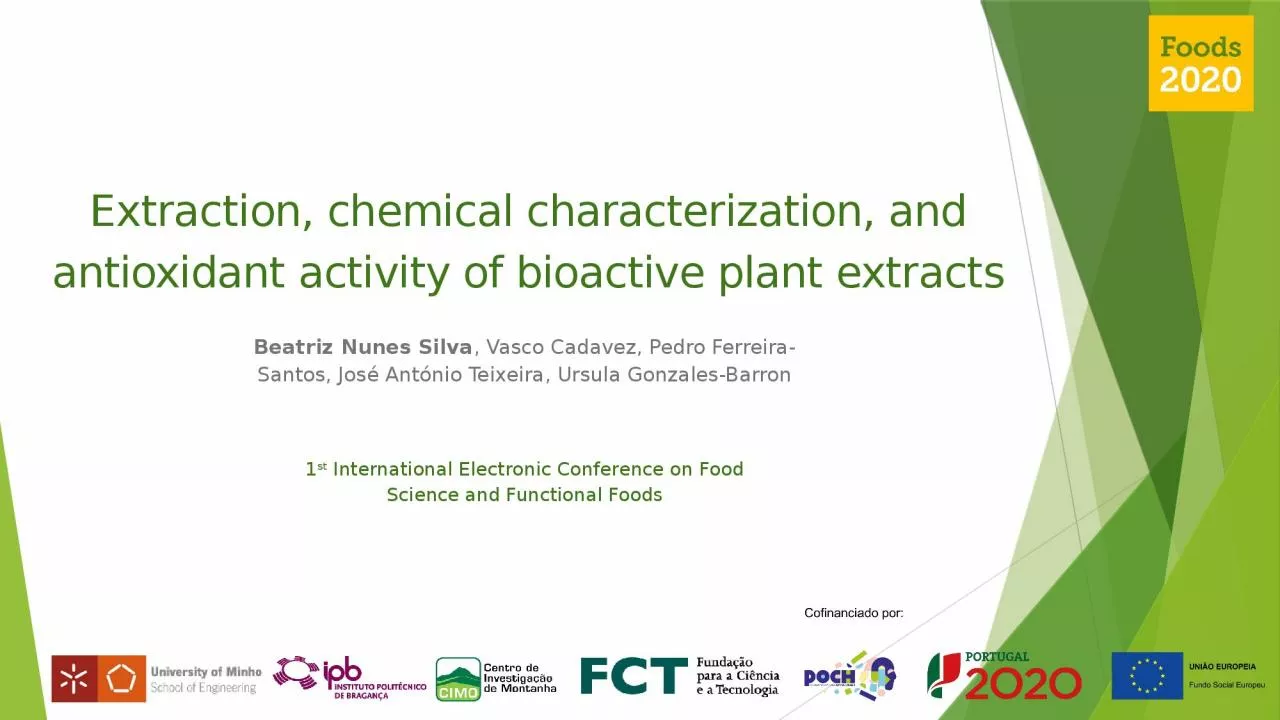

Beatriz Nunes Silva Vasco Cadavez Pedro FerreiraSantos José António Teixeira Ursula GonzalesBarron 1 st International Electronic Conference on Food Science and Functional Foods 2 Motivation ID: 1036580
Download Presentation The PPT/PDF document "Extraction, chemical characterization, a..." is the property of its rightful owner. Permission is granted to download and print the materials on this web site for personal, non-commercial use only, and to display it on your personal computer provided you do not modify the materials and that you retain all copyright notices contained in the materials. By downloading content from our website, you accept the terms of this agreement.
1. Extraction, chemical characterization, and antioxidant activity of bioactive plant extracts Beatriz Nunes Silva, Vasco Cadavez, Pedro Ferreira-Santos, José António Teixeira, Ursula Gonzales-Barron1st International Electronic Conference on Food Science and Functional Foods
2. 2 MotivationPlant extracts have been proposed as alternative biocides and antioxidants to be included in food productsThere is scientific evidence of the antimicrobial and antioxidant properties of several plantsSolid-liquid and Soxhlet extractions are often used in the food industryRosemaryLemon balmBasilTarragonSageSpearmint
3. 3 ObjectivesTo study the phytochemical and antioxidant profile of plant extracts (as obtained by distinct extraction methods and solvents)To assess the potential of plant extracts to be used as food preservatives
4. 4 MethodologyRosemaryLemon balmBasilTarragonSageSpearmintSolid-liquid ExtractionSoxhlet Extraction150 rpm, 60 ºC, 90mindH2O and Et70%7 recycles, 120 ºC dH2O; 80 ºC Et70%Chemical characterizationTotal Phenolic ContentTotal Flavonoid ContentAntioxidant activityDPPHABTSFRAPIdentification and quantification of individual phenolic compoundsUPLC-DAD
5. 5 RESULTSTPC and TFCindicates p < 0.05 between solvents for each plant extract
6. 6 RESULTSTPC and TFCindicates p < 0.05 between extraction methods for each aqueous plant extract
7. 7 RESULTSTPC and TFCHigher TPC in aqueous extracts fromSoxhlet extraction
8. 8 RESULTSTPC and TFCindicates p < 0.05 between extraction methods for each hydroethanolic plant extract
9. 9 RESULTSTPC and TFCHigher TPC in hydroethanolic extracts fromSolid-liquid extraction
10. 10 RESULTSTPC and TFCOverall:Et70(improved solubility) + solid-liquid extraction(lower temperature, reduced degradation)most effective combination to extract phenolic compounds
11. 11 RESULTSAntioxidant activitySolid-liquidSoxhletABTSDPPHFRAPmmol TE/g dry plantmmol Fe2+/g dry plantRegardless of the extraction method or solvent:lemon balm extracts highest antioxidant activitiestarragon extracts lowest antioxidant activities
12. 12 RESULTSIdentification and Quantification of Individual Phenolic Compounds15 compounds identifiedRosmarinic acidFerulic acidEllagic acidNaringinHesperidinResveratrolQuercetinp-coumaric acid + epicatechino-coumaric acidChlorogenic acidCinnamic acidSyringic acidVanillic acidKaempferol3,4-HBAPresent in all extractsPCA was conducted to visualize the influence of phenolic compounds on extracts differentiation
13. 13 RESULTSIdentification and Quantification of Individual Phenolic CompoundsHydroethanolic extracts: higher concentrations of rosmarinic acid, resveratrol, and hesperidinAqueous extracts: higher concentrations of vanillic and syringic acidsUnable to distinguish between solvents…
14. 14 RESULTSIdentification and Quantification of Individual Phenolic CompoundsUnable to distinguish between solvents……but good discrimination between methods!
15. 15 RESULTSIdentification and Quantification of Individual Phenolic CompoundsSoxhlet extracts: higher concentrations of rosmarinic acid, kaempferol, hesperidin and ellagic acidSolid-liquid extracts: higher concentrations of vanillic and syringic acids, resveratrol, and quercetin
16. 16 RESULTSIdentification and Quantification of Individual Phenolic CompoundsValuable results to help selecting the best method/solvent combination to achieve a specific phenolic compound!
17. 17 ConclusionsInsight on the phytochemical profile and antioxidant activity of plant extractsEvaluation of the effect of extraction methods and solventsDifferences between aqueous and ethanolic extractsDifferences between solid-liquid and Soxhlet techniquesOverall higher phenolic content: solid-liquid hydroethanolic extractsLemon balm extracts: highest TPC, TFC and antioxidant activitiesTarragon: “worst” results in all assays
18. BNS wishes to acknowledge the financial support provided by the Portuguese Foundation for Science and Technology (FCT) through the PhD grant SFRH/BD/137801/2018.The authors are grateful to EU PRIMA programme and the Portuguese Foundation for Science and Technology (FCT) for funding the ArtiSane Food project (PRIMA/0001/2018). Acknowledgements
19. Thank you! Any questions: beatrizsilva@ceb.uminho.pt1st International Electronic Conference on Food Science and Functional Foods